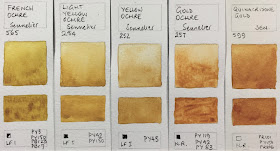It's been challenging testing the MG paints since they are made with a high honey content, making them tricky to for people to mail me samples. However people have been ingenious - as they have been with the Sennelier range - so I've tested all but 6 of them and they are beautiful paints, just best suited for studio use and/or less humid environments I think.
* I will be updating all the swatches during the first quarter of 2023.
The Gamboge swatch is fairly accurate but Indian Yellow is just a bit more orange than it looks here. PY110 is a perfect mid yellow-orange or orange-yellow colour.
These swatches are fairly accurate in hue.
These swatches are fairly accurate though the Permanent Alizarin Crimson has a slightly brown cast here that is not visible in reality. The Alizarin Crimson is the fugitive pigment PR83 so shouldn't be used in paintings that will be exposed to light. Permanent Alizarin is made from the lovely rich PR264 that mixes so well with PG7 to make blacks.
I find Quinacridone Rose to be a fabulous primary red as it mixes beautiful purples with almost any blue, but sometimes a more textural purple can be useful. the colours of these swatches are fairly accurate. Ultramarine Pink is now made with PV15.
The colour of these swatches if fairly accurate. PV14 and PV15 are lovely granulating pigments.
M.Graham Viridian is one of the stronger versions of this often weaker or more gentle pigment.
There is slightly more difference between Sap Green Permanent and Hooker's Green that shows here - the latter being less yellow. Either work as useful convenience foliage greens with the Sap being slightly brighter and the Hooker's being slightly more neutralised.
There are also plenty of lovely earth colours to choose from. I like the purity of the MG pigments - PY43 for yellow ochre... Naples Yellow is now listed as a single pigment PBr24.
...PBr7 for raw siena, PBr7 for Burnt Sienna. Transparent Red Oxide is now a single pigment PR101.
Those who use M.Graham watercolours speak very highly of them. Hopefully I'll be able to eventually try the whole lovely range, even though they don't suit my plein air style of painting.
 |
| M.Graham Watercolours - Hansa Yellow, Cadmium Yellow Light Bismuth Vandate Yellow, Azo Yellow, Hansa Yellow Deep. |
 |
| M.Graham Watercolours - Cadmium Yellow (not shown), Cadmium Yellow Deep (not shown), Gamboge, Indian Yellow, Cadmium Orange (not shown). |
 |
| M.Graham Watercolours - Azo Orange, Scarlet Pyrrol, Quinacridone Red, Cadmium Red Light, Naphthol Red. |
These swatches are fairly accurate though the Permanent Alizarin Crimson has a slightly brown cast here that is not visible in reality. The Alizarin Crimson is the fugitive pigment PR83 so shouldn't be used in paintings that will be exposed to light. Permanent Alizarin is made from the lovely rich PR264 that mixes so well with PG7 to make blacks.
 |
| M.Graham Watercolours - Pyrrol Red, Cadmium Red, Maroon Perylene, Alizarin Crimson, Permanent Alizarin Crimson. |
I find Quinacridone Rose to be a fabulous primary red as it mixes beautiful purples with almost any blue, but sometimes a more textural purple can be useful. the colours of these swatches are fairly accurate. Ultramarine Pink is now made with PV15.
 |
| M.Graham Watercolours - Cadmium Red Deep, Quinacridone Rose, Quinacridone Violet, Mineral Violet, Ultramarine Pink (original version). |
 |
| M.Graham Watercolours - Anthraquinone Blue, Cobalt Blue, Phthalo Blue Red Shade, Cerulean Blue, Cerulean Blue Deep. |
These swatches look slightly richer than in real life but are fairly accurate.
 |
| M.Graham Watercolours - Prussian Blue, Phthalo Blue, Manganese Blue Hue, Cobalt Teal, Turquoise. |
 |
| M.Graham Watercolours - Phthalo Green, Viridian (not shown), Phthalo Green Yellow Shade, Cobalt Green, Permanent Green Light. |
 |
| M.Graham Watercolours - Permanent Green Pale, Sap Green Permanent, Hooker's Green, Olive Green, Azo Green. |
There are also plenty of lovely earth colours to choose from. I like the purity of the MG pigments - PY43 for yellow ochre... Naples Yellow is now listed as a single pigment PBr24.
 |
| M.Graham Watercolours - , Yellow Ochre, Nickel Azo Yellow, Naples Yellow, Nickel Quinacridone Gold, Transparent Yellow Iron Oxide. |
...PBr7 for raw siena, PBr7 for Burnt Sienna. Transparent Red Oxide is now a single pigment PR101.
 |
| M.Graham Watercolours - Payne's Grey, Neutral Tint, Lamp Black (not shown), Chinese White, Titanium White Opaque (not shown). |
For paint-outs of other brands of watercolour, use the search button :-)










































